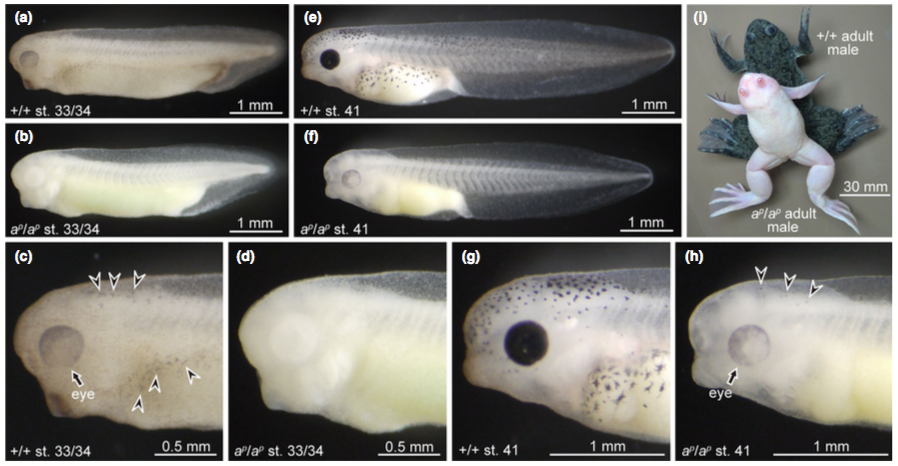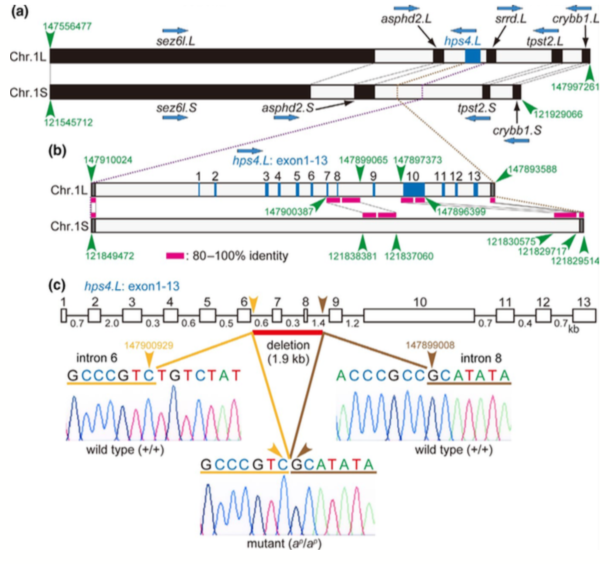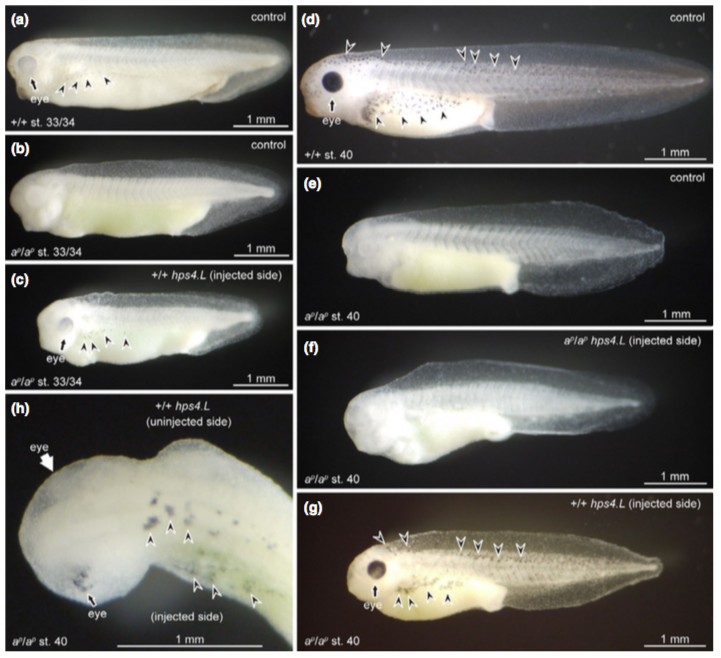hps4 gene responsible for periodic albino in Xenopus
Periodic albinism of a widely used albino mutant of Xenopus laevis caused by deletion of two exons in the Hermansky–Pudlak syndrome type 4 gene
Toshihiko Fukuzawa
Genes Cells. 2020 Nov 4. doi: 10.1111/gtc.12818.
Periodic albinism results in an albino mutant of Xenopus laevis, where a reduced amount of melanin appears in the retinal pigment epithelium (RPE) and melanophores at the late embryonic stage, followed by gradual depigmentation of both RPE and melanophores during metamorphosis. This study identifies hps4 gene (Hermansky-Pudlak syndrome type 4), as being responsible for periodic albinism of the albino mutant of X. laevis. HPS is a human disease characterized by hypopigmentation and bleeding disorder. The HPS gene encodes a component of the biogenesis of lysosome-related organelles (LROs) such as melanosomes and platelet dense granules. The periodic albino mutant of X. laevis may be useful for studying HPS and LRO biogenesis.
Click here to view article at Genes to Cells.
Click here to view article on Pubmed.
Click here to view article on Xenbase.
Abstract
The periodic albino mutant of Xenopus laevis is a recessive mutant, in which re- duced amounts of melanin appear in the retinal pigment epithelium (RPE) and in melanophores at the late embryonic stage, after which both RPE and melanophores gradually depigment. Three types of pigment cells (melanophores, iridophores and xanthophores) have been reported to be affected in this albino. However, the causa- tive gene of the periodic albinism remains unknown. Hermansky–Pudlak syndrome (HPS) is an autosomal recessive disorder that affects humans and mice, which is caused by defective biogenesis of lysosome-related organelles (LROs). Two subge- nomes (L and S) are present in the allotetraploid frog X. laevis. Comparison of genes between the chromosomes 1L and 1S revealed that the HPS type 4 (hps4) gene was present only in chromosome 1L. In the albino mutant, a 1.9 kb genomic deletion in the hps4.L gene including exons 7 and 8 caused a premature stop codon to create a truncated Hps4 protein. Injection of wild-type hps4.L mRNA into mutant embryos rescued the albino phenotype. These findings indicate that hps4 is a causative gene for the periodic albinism in X. laevis. The phenotype of this mutant should be reas- sessed from the perspective of LRO biogenesis.

Figure 1.
The time of melanin appearance in the eyes and melanophores in the periodic albino mutant is later than that of the wild type. (a–d) Stage 33/34 embryos; (e–h) stage 41 embryos; (i) adult frogs. Photographs of (c), (d), (g) and (h) are enlarged images of the head and trunk regions in (a), (b), (e) and (f), respectively. (a, c, e, g, i) Wild-type Xenopus laevis; (b, d, f, h, i) mutant X. laevis. Melanin appears in the eyes
(c, arrow) and melanophores (c, arrowheads) at stage 33/34 in the wild type (a, c), but not in the mutant (b, d). Small amounts of melanin begin to appear in the eyes (h, arrow) and melanophores (h, arrowheads) at stage 41 in the mutant (f, h). Although melanin-containing cells do not disappear in the wild type even after metamorphosis, they almost disappear during metamorphosis in the mutant (i).

Figure 2.
The hps4 gene is present only in chromosome 1L, and a 1.9 kb genomic deletion including two exons in the hps4.L gene occurs in the periodic albino mutant. (a) Schematic representation of Xenopus laevis genes in chromosome 1L containing hps4 locus and in chromosome 1S (v9.2, Xenbase). (b) Alignment of DNA sequences between hps4.L region in chromosome 1L and the corresponding position in chromosome 1S. (c) Schematic representation of hps4.L gene in the wild type and in the mutant. Wild-type hps4.L gene consists of 13 exons interrupted by 12 introns. DNA chromatograms show a 1.9 kb deletion between introns 6 and 8 in the hps4.L gene in the mutant (c, arrowheads). Accession numbers: +/+ hps4.L gene between exons 6 and 9, LC577764 (DDBJ); ap/ap hps4.L gene between exons 6 and 9, LC577765 (DDBJ).

Figure 4.
Injection of wild-type hps4.L mRNA, but not mutant hps4.L mRNA, into mutant embryos rescued the albino phenotype. (a–c) Stage 33/34 embryos; (d–h) stage 40 embryos. Uninjected control embryos of the wild type (a, d) and the mutant (b, e) were compared with mutant embryos injected with either mutant hps4.L mRNA (f) or wild-type hps4.L mRNA (c, g, h). Although melanin did not appear in mutant control embryos at stages 33/34 (b) and 40 (e), mutant embryos injected with wild-type hps4.L mRNA expressed melanin in the eyes (black arrows) and melanophores (arrowheads) at stages 33/34 (c) and 40 (g, h). The expression of melanin in mutant embryos injected with wild-type hps4.L mRNA (c, g) was similar to that of wild-type controls (a, d). Embryos injected with mutant hps4.L mRNA did not express melanin at stage 40 (f), and were similar to mutant controls (e). Dorsal view of the head and trunk regions of mutant embryo injected with wild-type hps4.L mRNA shows that melanin appeared in the eye of the injected area (h, black arrow), but not in the eye of the uninjected area (h, white arrow).
Adapted with permission from Wiley on behalf of Genes to Cells: Fukuzawa. (2020). Periodic albinism of a widely used albino mutant of Xenopus laevis caused by deletion of two exons in the Hermansky–Pudlak syndrome type 4 gene. Genes Cells. 2020 Nov 4. doi: 10.1111/gtc.12818.
This work is licensed under a Creative Commons Attribution 4.0 International License. The images or other third party material in this article are included in the article’s Creative Commons license, unless indicated otherwise in the credit line; if the material is not included under the Creative Commons license, users will need to obtain permission from the license holder to reproduce the material. To view a copy of this license, visit http://creativecommons.org/licenses/by/4.0/
Last Updated: 2020-12-07